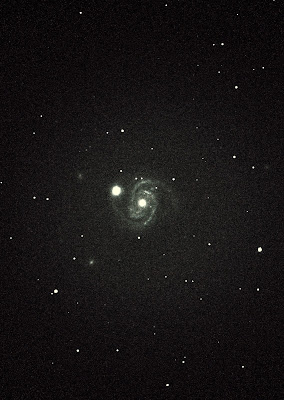Ceres is the first asteroid discovered, and still the largest body in the asteroid belt of the Solar System. Now dubbed "dwarf planet" (together with Pluto), its average distance from the Sun is slightly over 400 million kilometers.
M100 is a magnificent face-on spiral galaxy in Coma Berenices, distant of roughly 60 million light-years, that is some 1,5 million of million times farther ! And even so, they succeded to meet... at least from our perspective : on the evening of last March 26th, Ceres crossed in front of M100 in our sky, in a rare event not to be missed.
The picture below was taken at the beginning of the pass, with Ceres just "touching" the most external spiral arm of the galaxy. It is visible as a very bright spot at the upper left of the galactic nucleus.
Photo: Cristian Valenzuela / Observatorio del Pangue - March 26th, 2023
Canon 60D at prime focus of SCT Meade LX200 16" reduced at f/6, total exposure 10 minutes. North is up
A public observatory, displaying powerful, premium telescopes, under one of the best skies of the world, intended for the most enthusiastic visitors to whom we deliver personalized attention...
In short, welcome! Un observatorio astronómico público, con telescopios potentes de ultima generación, bajo uno de los mejores cielos del mundo, con servicio personalizado pensado para un público mas exigente...
En pocas palabras : bienvenidos
OBSERVATORIO DEL PANGUE : THE FACTS
EN FRANÇAIS, VOTRE ESPACE PRATIQUE :
EN ESPAÑOL : TODO SOBRE EL OBSERVATORIO DEL PANGUE
.
.□□□ See also:
DEEP SKY SOUTH : Remote Astronomy at Observatorio del Pangue
We still offer a service of hosting telescopes or private observatories for those stargazers who enjoy accessing to the Southern sky in optimal conditions. Don't worry for technical support or high speed internet, we provide it all.
For more information and availabilities, feel free to visit us at www.deepskysouth.org
□□□Vease también:
ALERTA EN TURISMO ASTRONÓMICO:
SEPAN DE LOS OBSERVATORIOS QUE NO LO SON !... (click aqui)
DEEP SKY SOUTH : Remote Astronomy at Observatorio del Pangue
We still offer a service of hosting telescopes or private observatories for those stargazers who enjoy accessing to the Southern sky in optimal conditions. Don't worry for technical support or high speed internet, we provide it all.
For more information and availabilities, feel free to visit us at www.deepskysouth.org
□□□Vease también:
ALERTA EN TURISMO ASTRONÓMICO:
SEPAN DE LOS OBSERVATORIOS QUE NO LO SON !... (click aqui)
□□□ CONSULTEN AQUI LAS PREGUNTAS FRECUENTES EN ASTRONOMÍA
IMAGEN ASTRONÓMICA DEL DÍA
□□□ ...Y DE PASO ECHEN UN VISTAZO A LA IMAGEN ASTRONÓMICA DEL DÍA :
 Click here to link to the original site "Astronomy Picture of the Day".
Click here to link to the original site "Astronomy Picture of the Day". Cliquer ici pour accéder à la version française "Image Astronomique du Jour".
Cliquer ici pour accéder à la version française "Image Astronomique du Jour"._________________________________________________________________________________________________________
